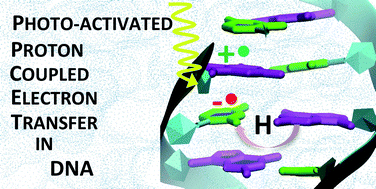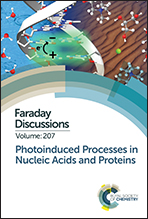Photoactivated proton coupled electron transfer in DNA: insights from quantum mechanical calculations†
Abstract
The energetics of the two main proton coupled electron transfer processes that could occur in DNA are determined by means of time dependent-DFT calculations, using the M052X functional and the polarizable continuum model to include solvent effect. This approach has been applied to fragments of GC and AT alternated duplexes containing up to 4 base pairs. In GC DNA, intra-strand G → C charge transfer (CT) can trigger inter-strand Proton Transfer (PT) involving the C anion, since the reaction is exothermic and the related energy barrier is <0.3 eV. In AT DNA, the minimum resulting from intra-strand A → T CT is not predicted to undergo inter-strand PT. These conclusions are in full agreement with the indication of time-resolved IR spectra. In both systems, inter-strand CT can be coupled to inter-strand PT, and the resulting minimum, reached after overcoming a moderate energy barrier (<0.4 eV), is close to a crossing region with the ground electronic state, providing a relatively fast non-radiative deactivation route.

- This article is part of the themed collection: Photoinduced Processes in Nucleic Acids and Proteins


 Please wait while we load your content...
Please wait while we load your content...